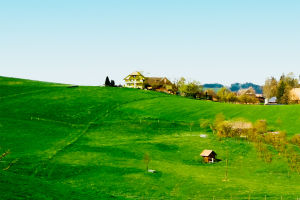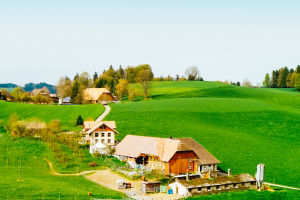A prairie ranch is a typical type of ranch typically found in the Great Plains region of North America, which includes parts of the United States and Canada.
The area is known for its vast open grasslands, and livestock such as cattle, sheep, and bison are often raised on ranches in the area.
Grassland ranches are often extensive, covering hundreds or thousands of acres of land. They often use a grazing system called rotational grazing, moving animals from one pasture to another to ensure the land is not overgrazed and can regenerate properly.
In addition to livestock, prairie pastures may also grow crops such as wheat, corn, and soybeans. These crops are often used to feed animals or sold for profit.
Prairie ranching is an important part of the economy and culture of the Great Plains region. Their rich history dates back to the 19th century when settlers moved west and began herding cattle on the open grasslands. Today, many prairie ranches are still family-owned and operated, and they continue to play an important role in providing food and supporting rural communities.
There are many famous ranches and ranches around the world, known for their beauty, history, and cultural significance. Here are some examples of ranches you can visit and enjoy:
1. Scottish Highlands - The Scottish Highlands have vast expanses of open land that have been used for centuries for grazing cattle and sheep. Visitors can join a guided tour or hike through the picturesque landscape to enjoy the views.
2. The Australian Outback - The Australian Outback is a vast and rugged region that is home to some of the most iconic ranching lands in the world. Visitors can experience life on a working ranch by taking a guided tour or cattle drive.
3. Icelandic Highlands - The Icelandic Highlands are known for their spectacular scenery and unique breeds of livestock such as Icelandic horses and sheep. Visitors can join a guided tour and explore the rugged terrain on horseback or foot.
4. Swiss Alps - The Swiss Alps are known for their stunning scenery and traditional mountain villages and pastures that have been used for centuries to support local farming and cheese-making traditions. Visitors can hike through the mountains or visit local farms and dairies.
5. American West - The American West is home to some of the most iconic ranches in the world, including the Great Plains and the Rocky Mountains. Visitors can experience life on a working ranch by taking a guided tour or cattle drive.
Notably, while many of these ranches are open to tourists, they are also working landscapes that are important to local communities and economies. Visitors are expected to respect the land and its inhabitants and obey any guidelines or rules established by the landowner or tour operator.
When entering a ranch, it is important to respect the land and its inhabitants. Keep the following points in mind:
1. Follow all signs and instructions: If there are any signs or instructions posted, be sure to read them carefully and follow them. These may include guidelines on where you can go, what you can do, and how to behave around livestock and other animals.
2. Stay on designated paths: Many ranches have designated paths or trails for visitors to follow. These are designed to keep visitors safe and prevent damage to the land. Make sure to stay on these paths and avoid wandering off-limits.
3. Respect the animals: If there are animals such as cows or horses on the ranch, be sure to give them enough space and avoid disturbing them. Do not feed or touch animals without permission from the ranch owner or operator.
4. Leave No Trace: When visiting the ranch, be sure to take all trash and avoid leaving any items or debris behind. This helps keep the land clean and minimizes the environmental impact of visitors.
5. Be prepared for the weather: Depending on the location and time of year, ranches can experience extreme weather conditions such as high temperatures, strong winds, or heavy rain. Make sure to check the weather forecast and dress appropriately for the weather.
Overall, the key to going on a ranch is to be respectful, responsible, and aware of your impact on the environment and the people and animals that live there.


